After 33 years, three national titles (2011, 2016, 2017) and nearly 700 wins, it is safe to safe Ohio State head coach Pete Hanson knows a thing or two about men’s college volleyball.
Although the game has changed his playing days at Kellogg Community College and Ball State in the late 1970s, Hanson has not only found a way to remain relevant, but keep his teams near the top of the MIVA as well as nationally.
The American Volleyball Coaches Association and Ohio State Athletics Hall of Famer has led his team to a 684-337 all-time record, 17 MIVA regular season crowns and 16 MIVA Tournament titles, while garnering himself four national coach of the year nods as well as 13 MIVA coach of the year accolades.
Hanson, however, is quick to note that his coaching would mean nothing without talented, hardworking players and a little luck. To learn more, VolleyMob sat down with this legendary coach ahead of last week’s final non-conference matches to talk about the game, his national championship squads and the 2018 team’s aspirations for a third-straight title.
You are a longtime MIVA guy, playing at Ball State in the 1970s and now coaching at Ohio State for the last 33 years. Can you compare the game from where it was then to where it is now?
Wow. It is decidedly different, that is for sure. That is an understatement. We clearly have more teams playing. I believe those teams that are currently playing are putting a lot more resources into their programs. The landscape of college athletics in general over the last 30 years has changed dramatically across the board: men’s sports, women’s sports, obviously football and basketball but the non-revenue sports as well.
When I was going through, you would climb into a couple of 15 passenger vans and there were even times that the athletes would be driving the vans. That doesn’t happen at all anymore and probably for good reason.
The scholarships certainly have gotten better. But the biggest thing with the game is just the level of the athletes and the generational difference in the athletes. I was a middle blocker at 6-feet-2 inches tall. That is pretty much unheard of in this day and age where you have blockers that are 7-feet tall to 6-8, 6-9, 6-5. Those types of things. Now you have setters that are 6-10, a Lloy Ball for example, or right side hitters that are 6-11 like Jake Hanes, a young man on our volleyball team. I think that has helped the game get better, get more physical and more dynamic. The tactics have changed because when we made the scoring transition from the old school scoring to rally scoring in the year 2000, coaches adapted and figured out that you have to do some things differently to win matches. What we are doing now and why we are doing it is a direct byproduct of the scoring system and everything.
How have you as a coach been able to evolve and stay relevant and keep your teams relevant through the game’s many changes?
Early on in my career I think… and a lot of young coaches do these things, so it is certainly nothing that I figured out … but when you are a young coach and starting, the best thing you can do is go out and work with other people, have other experiences and watch things. For me that was getting involved in a lot of USA programs, whether it was the youth national team or even a high performance camp, or back in the day they used to have these events called Olympic Sports Festivals. They were kind of mini-Olympics for high school and early college-aged athletes in a variety of sports. I was fortunate to get involved in two or three of those and worked with Jim McLaughlin, who at the time was coaching the men’s team at Southern Cal and went on to coach at Washington and is now one of the top coaches in women’s volleyball at the University of Notre Dame. I worked with Arnie Ball and Bill Neville and spent some time with Doug Beal. I found ways to better myself and learn about what other high level coaches were doing. I don’t know that any coach every invents anything, but you borrow ideas and kind of make them your own. You might tweak them a little bit as far as how they fit with your program or your athletes. You try to meld your philosophy from a lot of different philosophies I guess. That is how I got started and put together what I wanted to do for Ohio State.
Then, as you see the game change with the rules and things like that, you continue to think outside the box and take input of people and watch international volleyball and see how you need to adapt and move forward. I think as a coach, every so often, you need to interject some new and different things into your program and your players. I think that keeps them hungry for coming to practice every day and understanding that we are going to try this because we believe this is the best way to solve this problem. Nobody else is trying it, but by gosh we are going to try it. We believe it is going to work, and maybe it does, maybe it doesn’t, but I think it keeps the kids energized and it keeps the coaches energized. I have tried to just follow that path and continue to better myself a little bit and bring it back to the program.
Obviously something is working as you have three NCAA titles (2011, 2016, 2017), a runnerup finish, 12 NCAA Tournament appearances and 13 personal coach of the year awards.
Let me tell you what is working. When you have good volleyball players, all of a sudden your coaching gets really good too. I quote a gentleman who played football here at Ohio State and did a lot of stuff on ESPN, Cris Carter. I have heard him say a bunch of times, “It is not about the X’s and O’s, it is about the Jimmies and Joes.” And I kind of liken that to volleyball as well. I can have the best ideas, but if I don’t a Nic Szerszen or an Angel Aja, or a Steven Kehoe running my offense in 2011 and Sean Sangray playing opposite, we don’t necessarily win those types of matches and win those championships. Certainly we are trying to give them direction, but when you have guys and they buy into those directions, and then do all of the other little things, that is kind of what has helped build my resume. It is built on the good fortune of having some really good volleyball players at Ohio State.
They say it is harder to stay on top of the mountain than it is to get there. You have been on both sides of that. Do you agree with that statement?
I totally agree with that and I think in this day and age that is being proven out since the advent of the rally score. Obviously Coach (Al) Scates was on the top of the mountain and he dominated the top of the mountain for all of those years with 19 national championships (at UCLA), but I think times have changed. I think there is more parity across the board. I think volleyball in other parts of the United States on both the boys and the men’s side has gotten better, so it is not just exclusively a West Coast sport.
We are now getting more international flavor into our game. I think you can look back at some of the last 10 to 15 championships and the teams that were successful, not that they always had an international player, but you can pick a lot of them. Irvine won a championship with Kevin Tilly from France, who is in their national team program. Coach Dunphy (at Pepperdine) had a great two years of success when he had Paul Carroll, from Australia, who is one of the best opposites in the world. Obviously we have had success the last couple of years based on the play of Nic Szerszen, but we had some other guys around him. It doesn’t mean that you have to go that route. It is just the route that happened to fall into our laps with Nicolas, because his older sister (Anna) played at Ohio State (2006-10) and we just happened to be lucky enough that Nicolas was an outstanding player.
But, I think with the advent of rally score, the teams that you see winning, in my eyes, are typically the more experienced, veteran laden teams. I don’t know if you can go through the last 10-15 years and look at the roster, particularly the guys who played in that championship match, and find one with a lot of freshmen and sophomores. They were a lot of juniors and seniors and kids that had been through the wars and figured out how to mentally deal with the rally score situation of being aggressive, while trying to minimize your errors and playing a really physical game of volleyball, but also know how to manage bad situations. That was what we had in 2011, a very veteran group. And the last two, it was a bunch of juniors and seniors, but their freshman and sophomore years, those guys got beat up a lot and they weren’t very successful. That kind of motivated them not to go through that the last couple of years of their careers. I think that the game is so difficult right now with the quality of the players for those young kids to understand what is that fine line between can I make the aggressive swing and turn it into a point or do I make an error for the other team at a really critical juncture. You just don’t get that all of a sudden. It takes time for those kids to learn that. Right now, the teams that typically rise to the top in their respectively leagues are the older teams.
Has there been any talk of a 3-peat? Do you allow your team to talk about that at all as you head into this season?
I don’t mind a guy like Nicolas Szerszen or Max Hervoir, who are two of our seniors, telling our guys, hey, we want to win a third national championship, we want to defend our national championship. I don’t have a problem with those guys telling our younger people that this is a goal of mine and this should be a goal of the program’s. We don’t talk about it on a daily basis, but I think you are not doing yourselves justice if Nicolas Szerszen were to walk into our locker room and say ‘hey guys, it’s my senior year and I’m just going to put it on cruise control and make sure I graduate and stay healthy so I can have a nice life and great career continuing to play volleyball. I’ve got my two rings, so I really don’t care.’ But, Nicolas is not that type of guy.
We had a meeting partway through our fall training where the older guys told the younger guys ‘hey, if want to be in the position to play for that and accomplish what we have the last couple of years, we need more out of the younger guys. We need you to guys to challenge us more on a daily basis. We need you to be more bought in and take pride in what you are doing and call us out if we are not performing at a high level.’ That was a pretty mature statement, even for a senior, when a guy like Nic Szerszen is looking at Jake Hanes and saying you need to hit your best serve at me every day so I can get better and you can get better and maybe we will have a chance to play for championships at the end of year.
We might not get there, but at least it is out there. It is something we are pointing towards and training towards. We just try to make sure from a coaching perspective that we temper that with ‘hey Jake Hanes, I am not expecting you to be Miles Johnson. He was a two-time All-American and played for four years. Jake this is your first season putting on an Ohio State jersey and playing college volleyball. It is unfair of me to expect you to be Miles Johnson. You have to be Jakes Hanes.’ I am willing to take the good with the bad and there is going to be some bad, we know that, he is a redshirt freshman. But there is going to be a lot of good like this past weekend, when he played really well. We are just going to have to live with the ups and downs and manage him and if he has a bad day, hopefully somebody else can step in and cover for him and we come back to the practice gym and keep working on things.
The message from the coaching staff is let’s figure out who we are this year and let’s get as good as we can be and then if we are in the mix at the end of the year, then we have done a great job with these guys and they have done a great job. But we are not saying it is a failure year if we are not the last team standing on the last day of the season. That is not how we are going to measure this year. We are going to measure this year by did we do everything in our power to put the guys in a position, did they do everything in their power to put themselves in a position to have a chance at it. At the end of the day, look in the mirror, look at your teammate and say this is where we ended up.
How is this team different from those veteran teams that won the national championships in 2016 and 2017? Are there skills that one is better at than another?
I think we have the ability to be a little bit better defensively. Our back court defense can be better. I think our serving is going to be pretty similar to what we had last year with Nic. And if we can keep Jake on the floor, I think Jake has the ability to hit the serve a lot like Miles did, it is just about gaining consistency. I think Sanil Thomas is every bit as capable of running the offense, similar to what Christy (Blough) did the last couple of years. But, he has to have a learning curve, this is his first time of playing all of the time. Christy was a four year player and he just had an innate knowledge of what to do and when to do it. I think we are trying to get Sanil to understand those things and get a good handle on that and that is coming along. We are probably not as good of a sideout team quite yet, but a lot of that is just having a new setter. But, I think it is a group that has a hunger to play and to say we aren’t going to give up that trophy and that title willingly; we are going to make you fight for it. As long as they do that every day, whatever match we are playing and whoever we are playing, you may beat us, but by God you are going to get a good Buckeye effort based on how the last couple of teams performed and we are going to try to match those standards.
Your team is currently 5-2 heading into the weekend, with both losses being close five setters. You put yourself in good position heading into MIVA play, but what have you learned so far that will prepare you for a tough conference season?
I think we have learned that when we are focused and when our best guys step up and be our best guys, whether that is Nic Szerszen or Blake Leeson or Max Hervior or Sanil Thomas, the older guys… when those guys play to the level that they are capable of playing to, the younger guys can go out and feel comfortable and the level of their play gets elevated.
I think we have also learned that there has to be a higher level of consistency to beat a BYU or UCLA. We hung in that match at UCLA on sheer grit and competitive nature, because if you look at the box score, they outhit us and outblocked us and they did a lot of better things statistically, but we lost. Two out of the three were deuce sets where we had a chance to win them and could have, but we just didn’t execute at the right time. As a coach, those are good teaching moments I believe. You hate to say a loss is a good thing, but I think it is a motivating thing when you get that close and you don’t come out on top. You can look back and say do you remember that one play at this point in time, when had we done this, maybe we win that match or maybe it is a different outcome. You can use those matches as reminders going forward. As long as a player is open minded about it and says ‘yeah coach I can fix that and I can get better at that.’ If we can do those things and continue to kind of do what last year’s team did, which is take things match by match, point by point, just play whoever is in front of you, play as hard as you can play and whatever the outcome is, the outcome is.
One of the young ladies who writes for the campus newspaper asked me, well, last year you were 32-2 and this year you are 5-2. I said ya, we are not going 32-2. You don’t even need to write that right now. That is not realistic, I don’t know, we may lose five, 10 or 15 matches, but we are not worried about how many wins and losses we have, we are worried about where we are at the end of April and can we string together some wins at the end of April when it is playoff time and get ourselves in position. That is what we are training for, not to put up a gaudy record and then flame out in the first round or not get to the playoffs. The record doesn’t matter, let’s get better as we go, step by step and match by match.
Give us quick glimpse at the MIVA race this year.
I think all of the teams are improved. You look at Lewis and Loyola. Loyola goes out the initial weekend of the season and knocks of BYU in Provo, which is not an easy thing to do. Lewis is kind of hitting their stride and they have gotten some significant wins lately. Ball State is kind of dealing with similar things we are dealing with and that is having a new setter and getting guys to get into a good rhythm when you are under pressure and those types of things. And I expect that they will get things figured out and they will be in the mix at the end.
Fort Wayne is off to a great start. I think their guys are healthy, which they weren’t last year. McKendree is an up and coming program that I think is going to give people a battle every night if you are not ready in there and play hard and get after them. But it is a good strong league. You have to take care of your home court and then be able to go on the road and win some tough matches. The teams that can do that typically are the ones standing in a good spot at the end of the year. It is a long season and you have ups and downs and you have injuries. You may go on the road and it the week your guys are taking midterms and you haven’t had great practices leading up to a Lewis/Loyola weekend. How do you deal with that? You just never know. You just try to keep putting the guys in position to do as well as they can do, and hopefully they figure it out.
But, it is a challenge. We kind of went through that the last couple of years. Having a bullseye on your back typically brings out the best, especially when you are on the road: the best in that home team, the best in that home team’s crowd. We have some young guys who haven’t been through that before, how do they deal with that? I don’t know yet, but we will find out soon enough. There is enough veteran leadership I hope to get those guys through that. That is kind of what we are counting on.
Everyone knows about MIVA Player of the Year Nicolas Szerszen and Maxime Hervoir. Are there any unsung heroes on your team that aren’t big stars on the stat sheet?
I think a guy that is going to have an impact at some point in time for us, and I can’t really tell you in what way, shape or form, is Reese Devilbiss. He is a guy that we believe is a really, really good volleyball player that just hasn’t been able to get in front of a couple of older guys and those two older guys are a couple of French guys, in Max and Nic, who are seniors. Reese is an outside hitter, but he is an outstanding ball control guy, he can serve it well, he can play good defense. His attacking is getting better. He is going to be a factor in some matches going forward because something is going to happen and we are going to have to call on some guys. He is going to be there.
The other guy we have played a little bit besides Jake (Hanes) at opposite is Martin Lallemand. Martin is a freshman here from Belgium. He is a very skilled volleyball player, but he is just a young volleyball player. I think as Martin kind of goes through this season, and begins to understand what is all about, being on the road, travelling in a bus and having to get off the bus and go and play in a match, blah blah blah, those types of things… he will be someone that we can call on and get some positive results.
The other guy that I am really, really pleased with so far that didn’t have a track record of something we could build on is our libero Aaron Samarin. Aaron, was recruited a year behind Gabe Domecus, who became our libero for the last three and a half years. Last year Aaron actually had shoulder surgery and did a medical redshirt and did not play, didn’t even practice. So, he is a fourth-year junior this year and just is doing some nice things for not really having any game experience. He is mature, he is calm, he is taking responsibility. It is nice to know that position is being occupied by somebody who has been in the program and around guys like Gabe Domecus and saw how he took care of business and that sort of thing. Aaron is very, very on point, on task, very business-like and has just done a really good job for us. If you want to kind of say an unsung hero, I would point to Aaron at this point in time. Not having seen him play the last few years, he has really stepped in and done a really nice job for us.
So far Szerszen (3.71 kps, hitting .397), Hervoir (2.80 kps, .285) and Hanes (3.96 kps, .284) have done a nice job for you and helped lead a very efficient offense (.327). What else are you going to have to see from your team to be standing at the end of the season?
We just have to make sure that Sanil, our setter, understands situations and where the ball needs to go in certain situations. There are going to be mismatches that are going to favor Jake. Even if it might be late in sets and you are thinking it is Szerszen time, it might be Jake Hanes time. The matchup might be better over there with a 6-10 guy vs. a 6-3 outside blocker vs. setting the ball to Nic Szerszen, where the opponent has a trap block up on him and is sending the house up on him. Nic can typically deliver the mail even in those situations, but I think, as we go forward, we just have to get Sanil comfortable in crunch situations to be able to distribute the ball and put our team in the best opportunity to score, regardless of who it is. And then it becomes Jake’s responsibility or Max’s responsibility or Blake Leeson or Nick Laffin’s shot to win that rally.
I think Sanil has to not just say I’ve got Szerszen, he’s an All-American, he’s my guy. I can give him the ball anytime, anywhere and he is going to kill it, because that is not going to happen every night. He is not going to have an All-American night every night. He does the high percentage of the time, but he is human just like anybody else. I think as Sanil gets comfortable and figures that out, and we can stay balanced and make teams have to defend us across the whole net, we are going to have a chance. That is all we are asking for.
- Pete Hanson – Ohio State men’s volleyball vs Ball State in 2016 (Photo by Jay LaPrete)
- Ohio State celebration
- Ohio State huddle
- The 2018 Ohio State Men’s Volleyball team
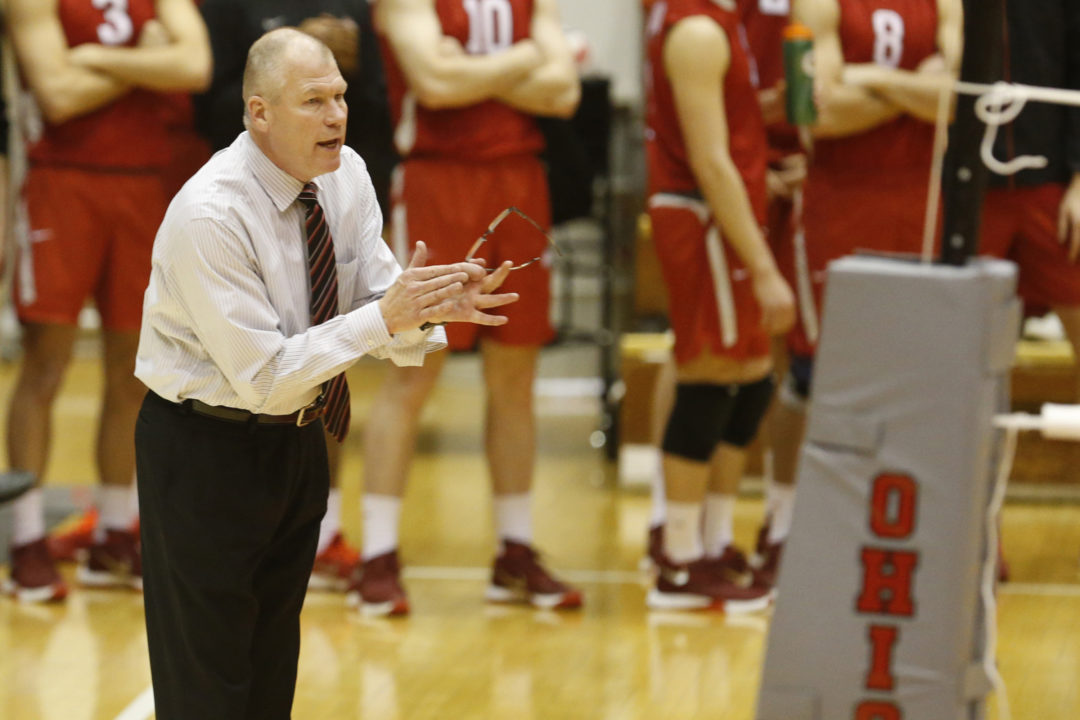
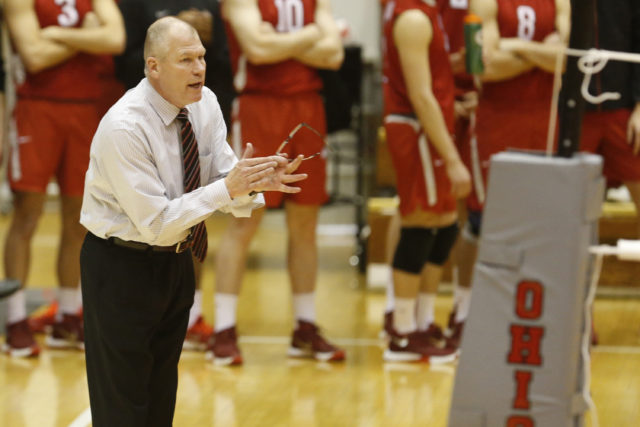
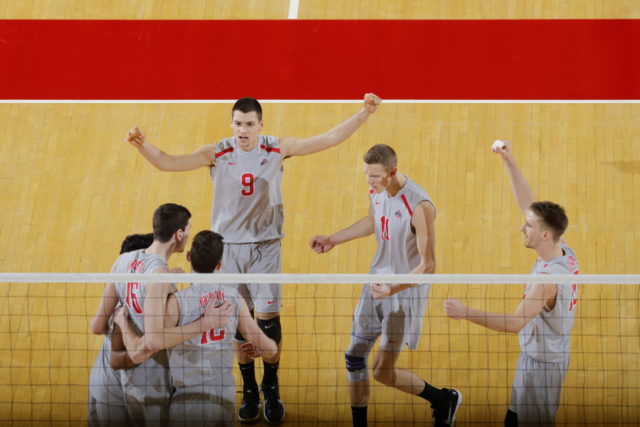
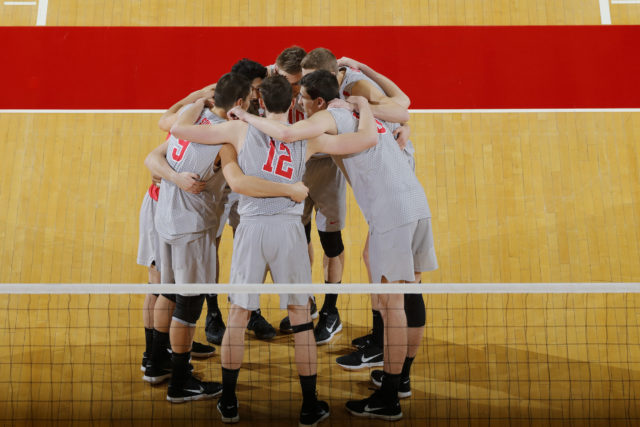
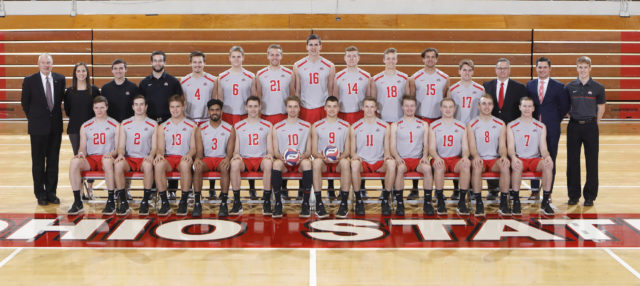
Leave a Reply